[C++ Primer Plus] 第8章、函数探幽(一)程序清单——内联、引用、格式化输入输出、模板、decltype
程序清单8.1(inline内联函数)
- #include<iostream>
- using namespace std;
- inline double square(double x) {//inline表示内联函数
- return x*x;
- }
- void main()
- {
- double a, b, c = 13.0;
- a = square(5.0);
- b = square(4.5+7.5);
- cout << "a=" << a << ",b=" << b << endl;
- cout << "c=" << c << ",c square=" << square(c++) << endl;
- cout << "Now c=" <<c<< endl;
- system("pause");
- }

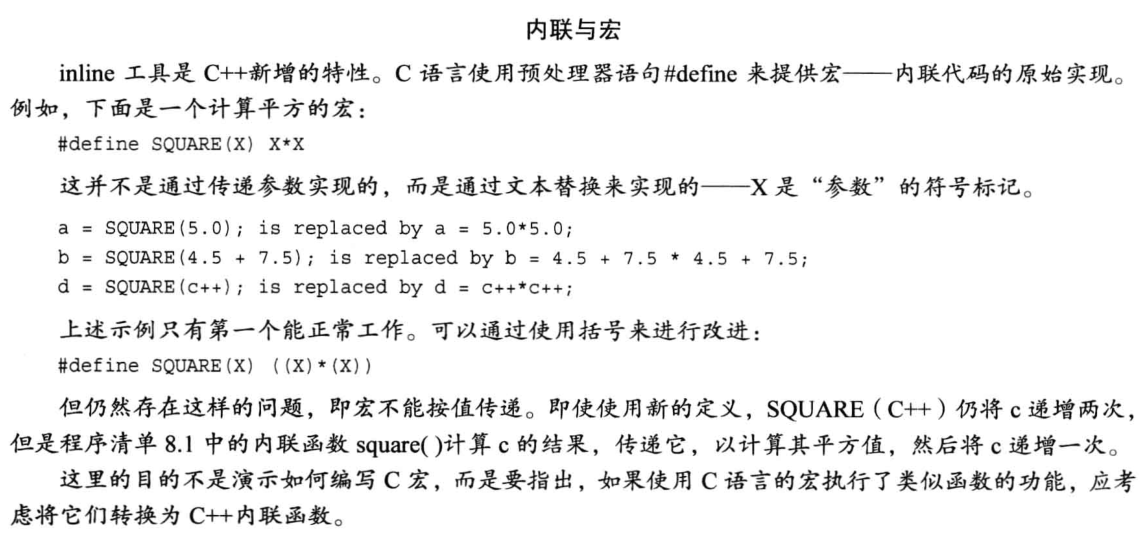
程序清单8.2+8.3(引用变量)
引用变量的主要用途是作为函数的形参:引用变量做参数,函数将使用原始数据。
- #include<iostream>
- using namespace std;
- void main()
- {
- int rat = ;
- int &rodent = rat;//将rodent的类型声明为int&,即指向int变量的引用
- cout << "rat=" <<rat<< ",rodent=" <<rodent<< endl;
- rodent++;
- cout << "Now,rat=" << rat << ",rodent=" << rodent << endl;
- cout << "rat address=" << &rat << endl;
- cout << "rodent address=" <<&rodent<< endl;
- cout << "************************************" << endl;
- int bunny = ;
- rodent = bunny;
- cout << "rat=" << rat << ",rodent=" << rodent<<",bunny="<<bunny << endl;
- cout << "bunny address=" << &bunny << endl;
- cout << "rodent address=" << &rodent << endl;
- system("pause");
- }
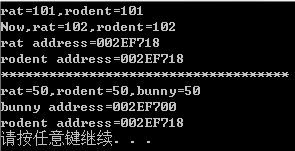

临时变量、引用参数和const
如果实参与引用参数不匹配,仅当参数为const引用时,C++将生成临时变量。
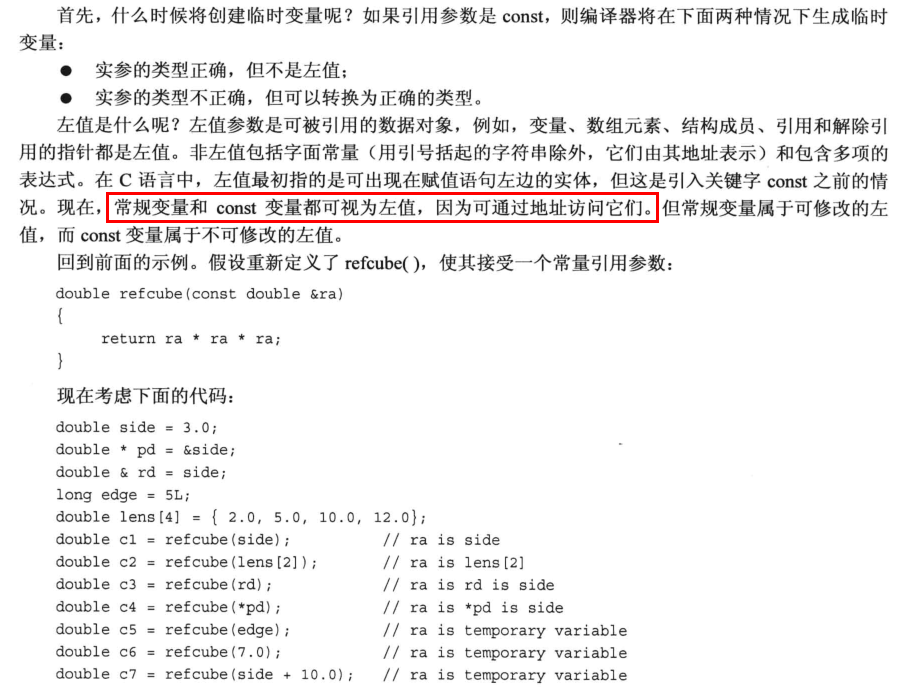
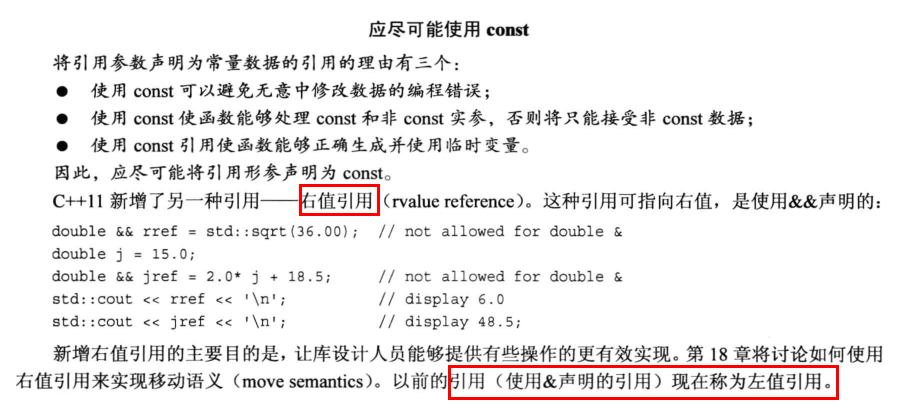
程序清单8.6
- #include<iostream>
- #include<string>
- using namespace std;
- struct free_throw
- {
- string name;
- int made;
- int attempt;
- float percent;
- };
- void display(const free_throw &ft) {
- cout << "Name=" << ft.name << endl;
- cout << "Made=" << ft.made << "\t\t";
- cout << "Attempt=" << ft.attempt<< "\t";
- cout << "Percent=" << ft.percent<<endl;
- }
- void set(free_throw &ft) {
- if (ft.attempt != )
- ft.percent = 100.0f*float(ft.made) / float(ft.attempt);
- else
- ft.percent = ;
- }
- free_throw & accumulate(free_throw &target,const free_throw &source) {
- target.attempt += source.attempt;
- target.made += source.made;
- set(target);
- return target;
- }
- void main()
- {
- free_throw one = { "If Branch",, };
- free_throw two = { "Andor Knott",, };
- free_throw three = { "Min Max",, };
- free_throw four = { "Whi Loo",, };
- free_throw five = { "Long Long",, };
- free_throw team = { "Throw",,};
- free_throw dup;
- set(one);
- display(one);
- accumulate(team, one);
- display(team);
- display(accumulate(team,two));
- accumulate(accumulate(team, three), four);
- display(team);
- dup = accumulate(team, five);//返回的team赋给dup
- cout << "Displaying team:" << endl;
- display(team);//team经过48行代码,已经发生了变化
- cout << "Displaying dup after assignment:" << endl;
- display(dup);
- set(four);
- accumulate(dup, five) = four;//four赋给dup
- cout << "Displaying dup after ill-advised assignment:" << endl;
- display(dup);
- system("pause");
- }
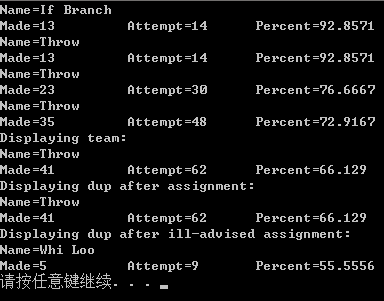
程序清单8.7
string:标准库允许把字符串字面值和字符字面值转换为 string 对象,当把 string 对象和字符字面值以及字符串字面值混在一条语句中使用时,必须确保加法运算符( + )的两侧运算对象至少有一个是 string:
- #include <iostream>
- #include <string>
- using namespace std;
- string version1(const string &s1, const string &s2) {
- string tmp;
- tmp = s2 + s1 + s2;
- return tmp;//返回main函数时,tmp不复存在,但tmp的内容被复制到临时存储单元
- }
- string & version2(string &s1, const string &s2) {//有副作用,改变了s1的内容
- s1 = s2 + s1 + s2;
- return s1;
- }
- string & version3(string &s1, const string &s2) {//坏设计
- string tmp;
- tmp = s2 + s1 + s2;
- return tmp;//返回main函数时,tmp内存已被释放,程序不能引用已经释放的内存
- }
- void main()
- {
- string input, copy, result;
- cout << "Enter a string:";
- getline(cin, input);//用于字符串的输入
- copy = input;//C++中,string可以直接赋值
- cout << "Your string as entered:" << input << endl;
- result = version1(input, "***");
- cout << "Your string enhanced:" << result << endl;
- cout << "Your original string:" << input << endl;
- result = version2(input, "###");
- cout << "Your string enhanced:" << result << endl;
- cout << "Your original string:" << input << endl;
- cout << "Resetting original string." << endl;
- input = copy;
- result = version3(input, "@@@");//version3返回地址值时报错,因为该地址已释放
- cout << "Your string enhanced:" << result << endl;
- cout << "Your original string:" << input << endl;
- system("pause");
- }

程序清单8.8(格式化输入输出)
- #include <iostream>
- #include <fstream>
- #include <cstdlib>
- using namespace std;
- const int LIMIT = ;
- void file_it(ostream &os,double fo,const double fe[],int n) {//参数os可以指向ostream对象(如cout),也可以指向ofstream对象(如fout)
- ios_base::fmtflags initial;//ios_base::fmtflags是存储这种信息所需的数据类型名称
- initial = os.setf(ios_base::fixed);//setf(ios_base::fixed)使用定点表示法 表示对象
- os.precision();//指定显示多少位小数(假定处于定点模式下)
- os << "Focal length of objective:" << fo << " mm"<<endl;
- os.setf(ios::showpoint);//使用小数点 表示对象,即使小数部分为0
- os.precision();
- os.width();//设置下一次输出操作使用的字段宽度,只在显示下一个值时有效
- os << "f.1. eyepiece";
- os.width();
- os << "magnification" << endl;
- for (int i = ; i < n; i++)
- {
- os.width();
- os << fe[i];
- os.width();
- os << int(fo / fe[i] + 0.5) << endl;
- }
- os.setf(initial);//返回调用它之前有效的所有格式化设置,即将对象回到传递给file_it()之前的状态
- //当程序将cout传递给file_it()时,cout的设置将被修改,然后被恢复;fout同样如此
- }
- void main()
- {
- ofstream fout;
- const char *fn = "ep-data.txt";
- fout.open(fn);
- if (!fout.is_open()) {
- cout << "Can't open "<< fn <<".Bye."<< endl;
- exit(EXIT_FAILURE);
- }
- double objective;
- cout << "Enter ……:";
- cin >> objective;
- double eps[LIMIT];
- cout << "Enter XXX" << endl;
- for (int i = ; i < LIMIT; i++)
- {
- cout << "Eyepiece #" << i + << ": ";
- cin >> eps[i];
- }
- file_it(fout, objective, eps, LIMIT);//将数据写入文件ep-data.txt
- file_it(cout, objective, eps, LIMIT);//将同样的信息以相同的格式显示到屏幕上
- cout << "Done" << endl;
- system("pause");
- }
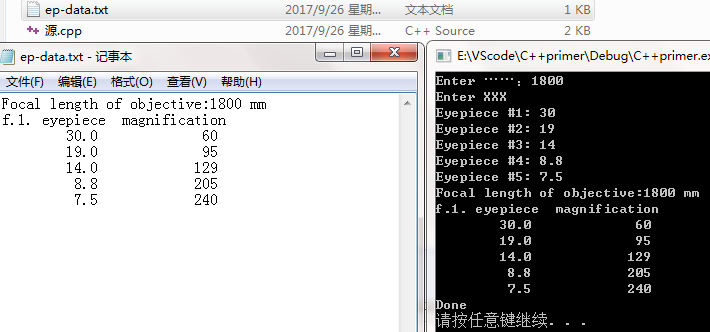
以下是一些常见的控制函数的:
dec 置基数为10 相当于"%d"
hex 置基数为16 相当于"%X"
oct 置基数为8 相当于"%o"
setfill(c) 设填充字符为c
setprecision(n) 设显示小数精度为n位
setw(n) 设域宽为n个字符
setioflags(ios::fixed) 固定的浮点显示
setioflags(ios::scientific) 指数表示
setiosflags(ios::left) 左对齐
setiosflags(ios::right) 右对齐
setiosflags(ios::skipws 忽略前导空白
setiosflags(ios::uppercase) 16进制数大写输出
setiosflags(ios::lowercase) 16进制小写输出
setiosflags(ios::showpoint) 强制显示小数点
setiosflags(ios::showpos) 强制显示符号
程序清单8.9(默认参数)
- #include <iostream>
- using namespace std;
- const int Size = ;
- char *left(const char *str, int n = );//默认n为1
- void main()
- {
- char sample[Size];
- cout << "Enter a string:\n";
- cin.get(sample, Size);
- char *p = left(sample, );//调用此方法后要记得delete
- cout << p << endl;
- delete[] p;
- p = left(sample);
- cout << p << endl;
- delete[] p;
- system("pause");
- }
- char *left(const char *str, int n) {//内部使用了new未delete,所以在main函数调用此方法后一定要记得delete
- if (n < )
- n = ;
- char *p = new char[n + ];//new和delete成对出现
- int i;
- for (i = ; i < n&&str[i]; i++)
- p[i] = str[i];
- while (i <= n)
- p[i++] = '\0';
- return p;
- }

程序清单8.10(函数重载)
- #include <iostream>
- using namespace std;
- char *left(const char *str, int n) {//内部使用了new未delete,所以在main函数调用此方法后一定要记得delete
- if (n < )
- n = ;
- char *p = new char[n + ];//new和delete成对出现
- int i;
- for (i = ; i < n&&str[i]; i++)
- p[i] = str[i];
- while (i <= n)
- p[i++] = '\0';
- return p;
- }
- unsigned long left(unsigned long num, unsigned ct) {
- if (ct == || num == )
- return ;
- unsigned digit = ;
- unsigned long n = num;
- while (n /= )
- digit++;
- if (digit > ct) {
- ct = digit - ct;
- while (ct--)
- num /= ;
- return num;
- }
- else
- return num;
- }
- void main()
- {
- char *trip = "Hawaii!!";
- unsigned long n = ;
- int i;
- char * temp;
- for (i = ; i < ; i++)
- {
- cout << left(n, i) << endl;
- temp = left(trip, i);
- cout << temp << endl;
- delete[] temp;
- }
- system("pause");
- }
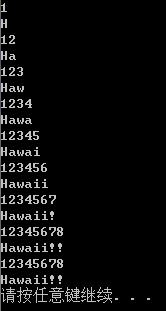
程序清单8.11+12(函数模板,模板重载)
- #include <iostream>
- using namespace std;
- template <typename T> //函数模板
- void swap2(T &a, T &b) { //引用 不能用swap函数名,用户自己定义的swap()函数与STL库定义的函数重载冲突
- T temp;
- temp = a;
- a = b;
- b = temp;
- }
- template <typename T>
- void swap2(T a[], T b[],int n) {
- T temp;
- for (int i = ; i < n; i++)
- {
- temp = a[i];
- a[i] = b[i];
- b[i] = temp;
- }
- }
- const int Size = ;
- template <class Te>//模板的另一种表示方式
- void show(Te a[]) {
- for (int i = ; i < Size; i++)
- {
- cout << a[i] << "\t";
- }
- cout << endl;
- }
- void main()
- {
- int i = , j = ;
- cout << "i=" << i << ",j=" << j << endl;
- swap2(i, j);
- cout << "Now,i=" << i << ",j=" << j << endl;
- double x[Size] = { ,,,, };
- double y[] = {,,,,};
- show(x);
- show(y);
- swap2(x, y ,Size);
- cout << "Now" << endl;
- show(x);
- show(y);
- system("pause");
- }
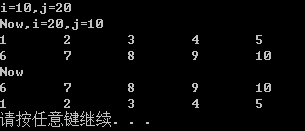
程序清单8.13(模板显示具体化)
- #include <iostream>
- using namespace std;
- //模板:交换a、b值
- template <typename T>
- void Swap(T &a, T &b) {
- T temp = a;
- a = b;
- b = temp;
- }
- struct job {
- char name[];
- double salary;
- int floor;
- };
- //显示具体化:交换结构体内部成员值
- template <> void Swap<job>(job &j1, job &j2) {//引用
- double t1;
- int t2;
- t1 = j1.salary;
- j1.salary = j2.salary;
- j2.salary = t1;
- t2 = j1.floor;
- j1.floor = j2.floor;
- j2.floor = t2;
- }
- void show(job &j) {//引用
- cout << j.name << ":$"<<j.salary<<" on floor "<<j.floor<<endl;
- }
- void main()
- {
- cout.precision();//指定显示多少位小数(假定处于定点模式下):看有没有set ios::fixed,如果没有的话, 是代表2位有效数字, 不是3位小数
- cout.setf(ios::fixed,ios::floatfield);//ios::fixed设置为定点输出格式,floatfield设置输出时按浮点格式,小数点后有6位数字
- int i = , j = ;
- cout << "i=" << i << ",j=" << j << endl;
- Swap(i, j);
- cout << "Now,i=" << i << ",j=" << j << endl;
- job sue = { "S Y",73000.60, };
- job sid = { "S T",78060.72, };
- show(sue);
- show(sid);
- Swap(sue, sid);
- show(sue);
- show(sid);
- system("pause");
- }
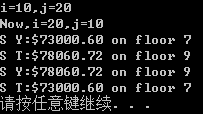
程序清单8.14
- #include <iostream>
- using namespace std;
- template <typename T>
- void show(T arr[],int n) {
- cout << "template A" << endl;
- for (int i = ; i < n; i++)
- cout << arr[i] << ' ';
- cout << endl;
- }
- template <typename T>
- void show(T * arr[], int n) {//指针数组:[]比*优先级高
- cout << "template B" << endl;
- for (int i = ; i < n; i++)
- cout << *arr[i] << ' ';
- cout << endl;
- }
- struct debt {
- char name[];
- double amount;
- };
- void main()
- {
- int thing[] = { ,,,,, };
- struct debt mr_E[] = {
- { "I W",2400.0 },
- { "U F",1300.0 },
- { "I S",1800.0 }
- };
- double *pd[];
- for (int i = ; i < ; i++)
- pd[i] = &mr_E[i].amount;
- cout << "Listen:" << endl;
- show(thing, );
- cout << "Listen debts:" << endl;
- show(pd, );
- system("pause");
- }
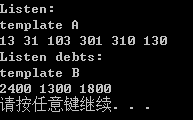
如果去掉 template B ,打印出来的将是地址
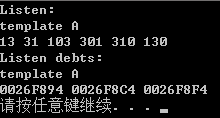
程序清单8.15
- #include <iostream>
- using namespace std;
- //返回小值
- template <typename T>
- T lesser(T a,T b) {
- return a < b ? a : b;
- }
- //先取绝对值,再返回绝对值中的小值
- int lesser(int a, int b) {
- a = a < ? -a : a;
- b = b < ? -b : b;
- return a < b ? a : b;
- }
- void main()
- {
- int m = , n = -;
- double x = 15.5, y = 25.9;
- cout << lesser(m, n) << endl;//调用函数
- cout << lesser(x, y) << endl;//调用模板函数
- cout << lesser<>(m, n) << endl;//<>表示调用模板函数
- cout << lesser<int>(x,y)<<endl;//<int>表示 显示实例化,强转xy值
- system("pause");
- }

关键字decltype

[C++ Primer Plus] 第8章、函数探幽(一)程序清单——内联、引用、格式化输入输出、模板、decltype的更多相关文章
- C++ primer plus读书笔记——第8章 函数探幽
第8章 函数探幽 1. 对于内联函数,编译器将使用相应的函数代码替换函数调用,程序无需跳到一个位置执行代码,再调回来.因此,内联函数的运行速度比常规函数稍快,但代价是需要占用更多内存. 2. 要使用内 ...
- 《C++ Primer Plus》第8章 函数探幽 学习笔记
C++ 扩展了 C 语言的函数功能.通过将 inline 关键字用于函数定义,并在首次调用该函数前提供其函数定义,可以使得 C++ 编译器将该函数视为内联函数.也就是说,编译器不是让程序跳到独立的代码 ...
- C++ Primer 5th 第6章 函数
正如第一章所说:C++的函数是一个能够完成一个功能的模块或者说是一段命名了的代码块. 如下图所示,函数可以重载,是一段实现某些功能命名了的代码. 一个完整的函数的构成有四部分: 1.返回类型 2.函数 ...
- 不可或缺 Windows Native (16) - C++: 函数重载, 缺省参数, 内联函数, 函数模板
[源码下载] 不可或缺 Windows Native (16) - C++: 函数重载, 缺省参数, 内联函数, 函数模板 作者:webabcd 介绍不可或缺 Windows Native 之 C++ ...
- 《C++ Primer Plus 6th》读书笔记 - 第8章 函数探幽
1. 摘录 默认参数指的是当函数调用中省略了实参时自动使用的一个值. 默认参数并非编程方面的重大突破,而只是提供了一种便捷的方式.使用默认参数,可以减少要定义的析构函数.方法以及方法重载的数量. 试图 ...
- C Primer Plus 第9章 函数 编程练习
复习题: 8. int choice(int a,int b,int c){ int max; max = a; if (b > max) max = b; if (c > max) ma ...
- 第四章 函数之lambda 表达式和内置函数
4.5 lambda 表达式 用于表示简单的函数. # 三元运算,为了解决简单的if else的情况,如:if 1 == 1: a = 123else: a = 456# 相当于a = 1 ...
- 【C++】《C++ Primer 》第六章
第六章 函数 一.函数基础 函数定义:包括返回类型.函数名字和0个或者多个形参(parameter)组成的列表和函数体. 调用运算符:调用运算符的形式是一对圆括号 (),作用于一个表达式,该表达式是函 ...
- C++—函数探幽
一.内联函数 1.内联函数的机制 内联函数是C++为提高程序运行速度而做的一项改进. 函数调用机制:常规函数调用使程序使程序跳到被掉函数的地址,并在函数结束时返回. 内联函数的机制:内联函数的代码与其 ...
随机推荐
- ECC椭圆曲线以及计算出公钥的过程(BTC为例)
ECC概念 全称 “ Ellipse Curve Cryptography ” means “ 椭圆 曲线 密码学 ”. 传统加密方法大多基于大质数因子分解困难性来实现,ECC则是通过椭圆曲线方程式 ...
- ublox TMOD2
Survey_in模式就是为了当满足下面的条件的时候,自动跳转到fixmod
- webToImage (网页转图片)模块试用分享
模块介绍: 本模块封装了把 webview 转换成图片的功能.调用本模块的transImage接口,可把当前 webview显示的内容转换成一张图片.注意,本模块只能把当前的webview页面转换为图 ...
- 如何把原生小程序项目合并的mpvue项目中
当时的情景是这样的: 使用mpvue写微信小程序,写着写着项目写到一半了,突然间不想这样继续写了,想切换回原生小程序语法去写剩余部分. 如下图,红色框里的功能是已经用mpvue完成的功能,绿色框部分的 ...
- 转载--python模块
模块,用一砣代码实现了某个功能的代码集合. 类似于函数式编程和面向过程编程,函数式编程则完成一个功能,其他代码用来调用即可,提供了代码的重用性和代码间的耦合.而对于一个复杂的功能来,可能需要多个函数才 ...
- 核心思想:决定你是富人还是穷人的11条标准(有强烈的赚钱意识,这也是他血液里的东西,太精彩了)good
原文地址:决定你是富人还是穷人的11条标准作者:谢仲华 1.自我认知 穷人:很少想到如何去赚钱和如何才能赚到钱,认为自己一辈子就该这样,不相信会有什么改变. 富人:骨子里就深信自己生下来不是要做穷人, ...
- 洛谷P4778 Counting swaps 数论
正解:数论 解题报告: 传送门! 首先考虑最终的状态是固定的,所以可以知道初始状态的每个数要去哪个地方,就可以考虑给每个数$a$连一条边,指向一个数$b$,表示$a$最后要移至$b$所在的位置 显然每 ...
- C++ opencv调用resize修改插值方式遇到的坑
opencv提供的热死则函数原型如下:void resize(InputArray src, OutputArray dst, Size dsize, double fx=0, double fy=0 ...
- 温习排序算法(基于C指针)
以前学过的数据结构课,貌似已经忘得一干二净了,偶然又翻起,书中最后一章详细介绍了7种排序算法,现在对其中4种做个总结.(为啥只总结4种,当然是因为偷懒,只想总结简单又常用的!) 先贴一张排序分类图: ...
- C++ STL学习之 空间配置器(allocator)
众所周知,一般情况下,一个程序包括数据结构和相应的算法,而数据结构作为存储数据的组织形式,与内存空间有着密切的联系. 在C++ STL中,空间配置器便是用来实现内存空间(一般是内存,也可以是硬盘等空间 ...
